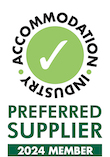Crappy Office Washroom? Here’s How to Immediately Improve Hygiene
Many employees spend most of their daytime hours in the office. Offices have become like a second home to workers. Employers are obligated to ensure the health of employees including hygiene needs.
Conditions in the work environment can have a positive or negative impact on workers. When workers are healthy, they are happier and more productive.
A 2019 survey shows the average Australian is absent from work for 11.2 days every year. This costs the economy over $35 billion in lost productivity and wasted wages.
 Source of Information: dhs
Source of Information: dhs
Granted, not all sick days taken are a result of genuine health issues. However, employers still need to ensure their staff remain as healthy as possible.
One of the simplest ways is to keep your office restrooms clean.
According to a study published in Applied and Environmental Microbiology, 77,900 different types of viruses and bacteria were found in shared restrooms.
They concluded that surfaces in these areas were likely to carry infectious pathogens.
This may seem obvious. Unfortunately, some workplace restrooms leave room for improvement. The importance of washrooms should not be taken for granted.
Importance of Hygienic Office Washrooms
1. Promotes a Healthy Work Environment
A healthy work environment is one of the minimum requirements for productive work. No one likes an unsanitary restroom, especially if they frequent it multiple times a day.
Dirty restrooms affect the morale of workers and they will eventually avoid them. This could lead to health problems and digestive issues.
Work time will also be lost as they search for alternatives.
Restrooms play host to numerous disease-carrying germs which can cause sickness.
“Hygiene is Two Thirds of Health” - Lebanese Proverb
The WHO has identified illnesses related to excreta - a common feature in dirty bathrooms. The more common ones that can be transmitted in commercial office settings include:
- E-coli related infections (abdominal cramps, bloody diarrhoea, fever, vomiting)
- Salmonellosis/ Food Poisoning
- Hepatitis A
- Norovirus
The common cold and the current COVID-19 are also easily spread through surface contact.
Employees may need to take time off work to recover from the effects of these illnesses. It is prudent for managers to encourage cleanliness and good hygiene practices.
2. Employees Feel Valued & Appreciated
Providing a clean washroom shows your employees that you care for their wellbeing.
83% of American employees believe the condition of workplace washrooms indicates how much their organisation values them. - The Healthy Hand Washing Survey, 2012
A survey showed that employees value their jobs more when restrooms are stocked with high-quality personal care supplies.
These include paper towel dispensers, soap and air fresheners. They also appreciated restroom mats and professional cleaning services.
Keeping washrooms employee-friendly is a small indication of how employers treat their employees.
It might not directly affect employee retention, it is a gesture that is sure to improve morale. A satisfied worker is more likely to go above and beyond to achieve organisational goals.
3. Improves Company Image
Imagine you have an important client who needs to use your bathrooms before a meeting. They enter the washroom and find it unclean or unsanitary. They will probably avoid using the facilities or feel disgusted.
This will make a negative impression on their view of the company as a whole. They will probably judge you on the state of the toilets and it may affect your relations with them.
It is clear the cleanliness of your washrooms indicates your level of professionalism. The state of your washrooms has an impact on how others view your organisation; hygiene standards need to be excellent.
Now you can see why it is essential to keep your restrooms pristine. Not only for aesthetic and hygiene reasons but to also improve your bottom line.
There is no need for a complete overhaul. Try these 3 simple tweaks to improve your workplace washroom hygiene.
Tips to Keeping the Office Toilet Clean
1. Provide Sufficient Supply of Consumables
Washroom supplies get depleted quickly. Replenishing them is an important part of proper bathroom maintenance. These include toilet paper, hand towels and soap. Their importance cannot be trivialized and here’s why:
Tissue Paper
The worst thing that can possibly happen in a washroom is a lack of tissue paper. With new tissue systems and the ability to purchase bulk toilet paper, it is nearly impossible to run out of this bathroom essential.
Using a double-roll coreless dispenser, the automatic drop-down system ensures for continuous service. As soon as the first toilet roll is finished, the second drops into place for a constant supply.
Australian Linen Supply will let you forget about running out of tissue paper. With up to 3,000 two-ply sheets, your employees won’t be worried either.
Hand Washing Soap
Our mothers always told us to wash our hands after going to the toilet and with good reason.
According to WHO, washing your hands with soap reduces the chances of diarrhoea by a third.
COVID-19 is the key reason all your employees should take handwashing very seriously. In order to prevent the spread of highly infectious diseases at work, you need to help keep their hands clean.
Make sure your bathrooms always have adequate amounts of soap. This should be combined with all staff washing their hands for at least 20 seconds (or sing happy birthday twice).
Paper Towels
After washing, some bacteria still remain so the hands need to be dried thoroughly.
Bacteria prefer wet hands and are more easily spread.
Research by a top UK university showed that paper towels were the best option for drying hands. Rubbing hands under the dryer may result in more bacteria on the surface of your hands.
A paper hand towel dispenser allows for continuous access to hand drying materials. Choose a dispenser such as the Cormatic Paper Dispenser.
It has no lever, buttons or cranks to reduce contact and maintain hygiene.
It also has a lock to stop users from pilfering the hand towels in high-traffic washrooms.
2. Establish a Cleaning Sequence
 Source: freestocks.org
Source: freestocks.org
There should be no recontamination during the cleaning process. Otherwise, the whole activity is counterproductive.
By following this set cleaning sequence, the cleaner can ensure that surfaces are clean and disinfected.
Step 1: Place Cautionary Signs & Check for Damage
‘Caution Wet Floor’ signs should be placed outside the washroom.
They will warn people of the wet floor hazard and reduce the risk of sustaining any injuries.
Step 2: Empty, Sweep & Refill
Traffic in washrooms quickly fills trash containers which need to be regularly emptied.
After removing all debris in tissue and feminine hygiene dispensers, refill dispensers. Make sure the soap dispenser is at maximum capacity. As shown above, there is no excuse for lack of hygiene products.
Finally, dust all vents, lights and partitions and sweep the floor.
Step 3: Pre-Treat Toilets & Urinals
Pour toilet cleaner and disinfectant around the flush ring and bowl and allow it to sit for a few minutes.
The contact time between the chemical and the surface needs to be sufficient enough to eliminate stains, bacteria and germs.
Step 4: Clean Sink Bowls, Taps, Mirrors and Countertops
A 2013 study shows that sinks contained more bacteria than any other place in bathrooms.
Germs are commonly spread through touch. When someone uses the toilet and touches the sink, those surfaces become contaminated.
It is essential to use disinfectant on all sinks and countertops. Highly polished mirrors give an extra shine and should be kept streak-free.
Step 5: Scrub Toilets & Urinals
Toilets and urinals need to be scrubbed thoroughly using a hardy brush.
The cleaner should focus on the underside of the flush ring which can harbour bacteria. Flushing after scrubbing is crucial.
Step 6: Mop the Floor
Washroom floors become messy, slippery and breeding grounds for hundreds of harmful bacteria.
It is important to mop with an anti-bacterial solution, starting from the furthest corner.
All corners and edges also need to be washed as they collect debris and dirt particles.
Step 7: Clean All Equipment & Report Damage
It is important to rinse all equipment and leave to dry in a well-ventilated area. Cleaning materials can easily transfer germs during the next usage.
Any damaged or broken equipment in the restroom should be reported to the supervisor. An inventory of existing and required stock of perishables should be taken daily.
3. Perform Scheduled Cleaning
The size of the business and the foot traffic you get will determine the frequency of daily cleaning.
The average office worker visits the toilet three or four times a day. If you own or manage an average-sized facility, this will amount to over 1 million trips per year.
Numbers depend on the size of the company and the number of visitors who frequent your workplace. Your cleaning schedule needs to be in line with this.
These tips may help you determine how often your restrooms should be cleaned.
-
Washrooms Must Be Cleaned at least Once a Day
There is no exception to this rule. Think about the size of your business, the location and how many people move in and out of the premises.
Small and medium-sized enterprises can get away with one good scrub per day, with mop ups throughout the day.
The cleaning supervisor will ultimately determine how often the restrooms are washed but. It is your duty to make sure they perform regular check-ups.
-
Do Not Wait Until the Restroom Looks Dirty
By the time a washroom looks dirty, there is a substantial amount of germs and bacteria present.
This means your staff may have already been exposed to disease-causing pathogens.
Avoid this with daily cleanings.
-
Learn the Industry’s Cleaning Requirements
Every industry has its own requirements when it comes to hygiene regulations. It will be helpful to do your research and implement the stipulated guidelines.
-
Periodical Deep Cleaning
Deep cleaning is a necessity as scum, mould and mildew accumulate over time. This is done either by machine or hand using potent chemicals which are not used daily.
Deep cleaning should happen periodically as advised in the table below.
| Floors | Machine scrub | Removes residue from grouting | Every 2 weeks |
| Walls | Hand scrub with a coarse brush | Removes residue from grouting | Once a month |
| Waste Bins | Hand scrub | Removes hardened residue | Every 2 weeks |
| Sinks | Hand scrub with a coarse pad | Removes accumulated scum & stains | Once a week |
| Toilet Bowls & Urinals | Hand scrub exterior and inner rim with a coarse pad | Removes stains | Once a week |
| Soap Dispensers | Exterior hand scrubbing | Removes dirt from joints | Once a week |
| Soap Dispensers | Dismantling | Clears accumulated residue | Once a week |
| Paper Towel Dispensers | Exterior hand scrubbing | Removes dirt from joints | Once a week |
| Air Conditioning Fans | Wiping | Removes dust | Once a week |
Strive for a More Hygienic Workplace Bathroom
Maintaining a flawless washroom environment isn’t always easy. You may incur expenses and require extra manpower.
These are not reasons to neglect this little space in your business.
Provide the necessities for your employees and customers to feel comfortable during their day.
The most important basic requirement? Tissue paper. Buy it in bulk from Australia Linen Supply and forget the burden as you tackle other ways to improve your business.
Contact ALS today and say goodbye to issues with your tissues.
Source: Rawpixel

















